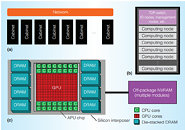Monday, August 3rd 2015

AMD Details Exascale Heterogenous Processor (EHP) for Supercomputers
AMD published a paper with the IEEE for a new high-density computing device concept, which it calls the Exascale Heterogenous Processor or (EHP). It may be a similar acronym to APU (accelerated processing unit), but is both similar and different to it in many ways, which make it suitable for high-density supercomputing nodes. The EHP is a chip that has quite a bit in common with the recently launched "Fiji" GPU, that drives the company's flagship Radeon R9 Fury X graphics card.
The EHP is a combination of a main die, housing a large number of CPU cores, a large GPGPU unit, and an interposer, which connects the main die to 32 GB of HBM2 memory that's on-package, and is used as both main-memory and memory for the integrated GPGPU unit, without memory partitioning, using hUMA (heterogeneous unified memory access). The CPU component consists of 32 cores likely based on the "Zen" micro-architecture, using eight "Zen" quad-core subunits. There's no word on the CU (compute unit) count of the GPGPU core. The EHP in itself will be highly scalable. AMD hopes to get a working sample of this chip out by 2016-17.
Source:
Bitsandchips.it
The EHP is a combination of a main die, housing a large number of CPU cores, a large GPGPU unit, and an interposer, which connects the main die to 32 GB of HBM2 memory that's on-package, and is used as both main-memory and memory for the integrated GPGPU unit, without memory partitioning, using hUMA (heterogeneous unified memory access). The CPU component consists of 32 cores likely based on the "Zen" micro-architecture, using eight "Zen" quad-core subunits. There's no word on the CU (compute unit) count of the GPGPU core. The EHP in itself will be highly scalable. AMD hopes to get a working sample of this chip out by 2016-17.

28 Comments on AMD Details Exascale Heterogenous Processor (EHP) for Supercomputers